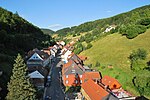Emperor William Shaft
Clausthal-ZellerfeldFormer mines in GermanyFormer power stations in GermanyUnderground mines in GermanyWilhelm II, German Emperor

The Emperor William Shaft (German: Kaiser-Wilhelm-Schacht or Schacht Kaiser Wilhelm II.) was the central hoisting and man-riding shaft of the lead and zinc mine in Clausthal-Zellerfeld in the Upper Harz in central Germany. It was sited on the Burgstatt Lode (Burgstätter Gangzug). The surface installations were located in the borough of Clausthal on No. 24 Erzstraße, near the present-day mining institute of the University of Technology.
Excerpt from the Wikipedia article Emperor William Shaft (License: CC BY-SA 3.0, Authors, Images).Emperor William Shaft
Erzstraße,
Geographical coordinates (GPS) Address Phone number Website Nearby Places Show on map
Geographical coordinates (GPS)
| Latitude | Longitude |
|---|---|
| N 51.804166666667 ° | E 10.344444444444 ° |
Address
Harzwasserwerke Betriebshof Clausthal
Erzstraße 24
38678 , Clausthal (Clausthal-Zellerfeld)
Lower Saxony, Germany
Open on Google Maps










